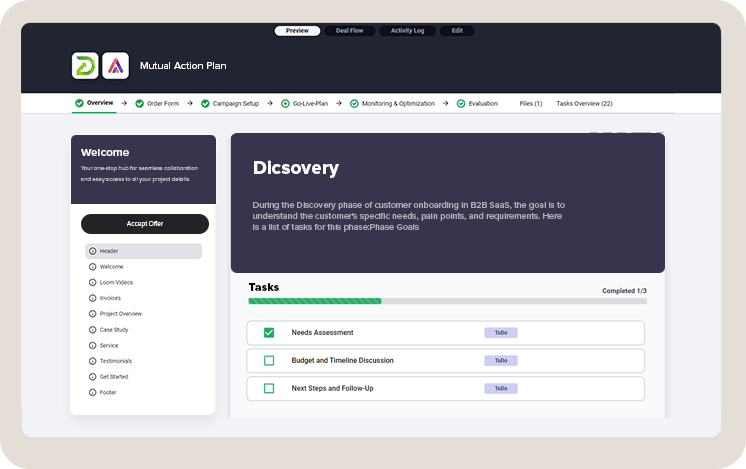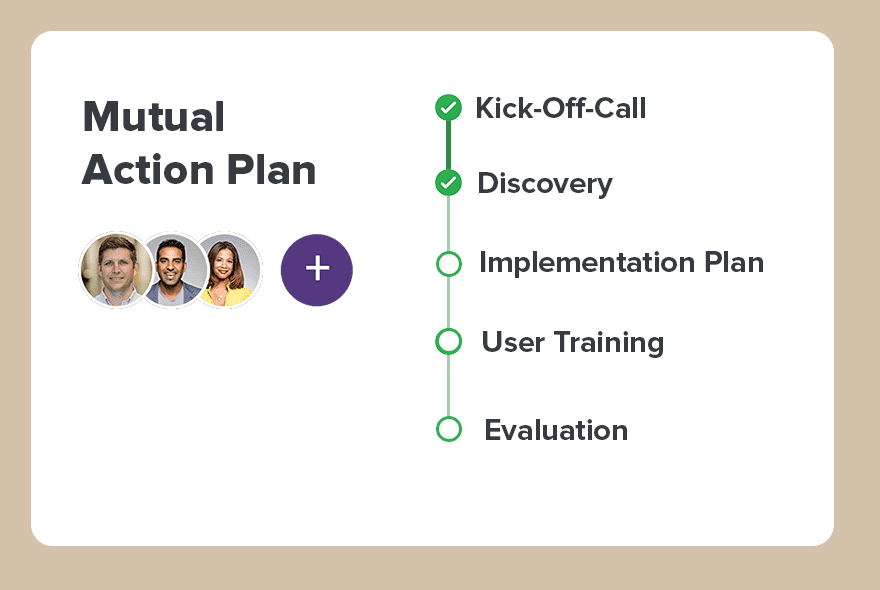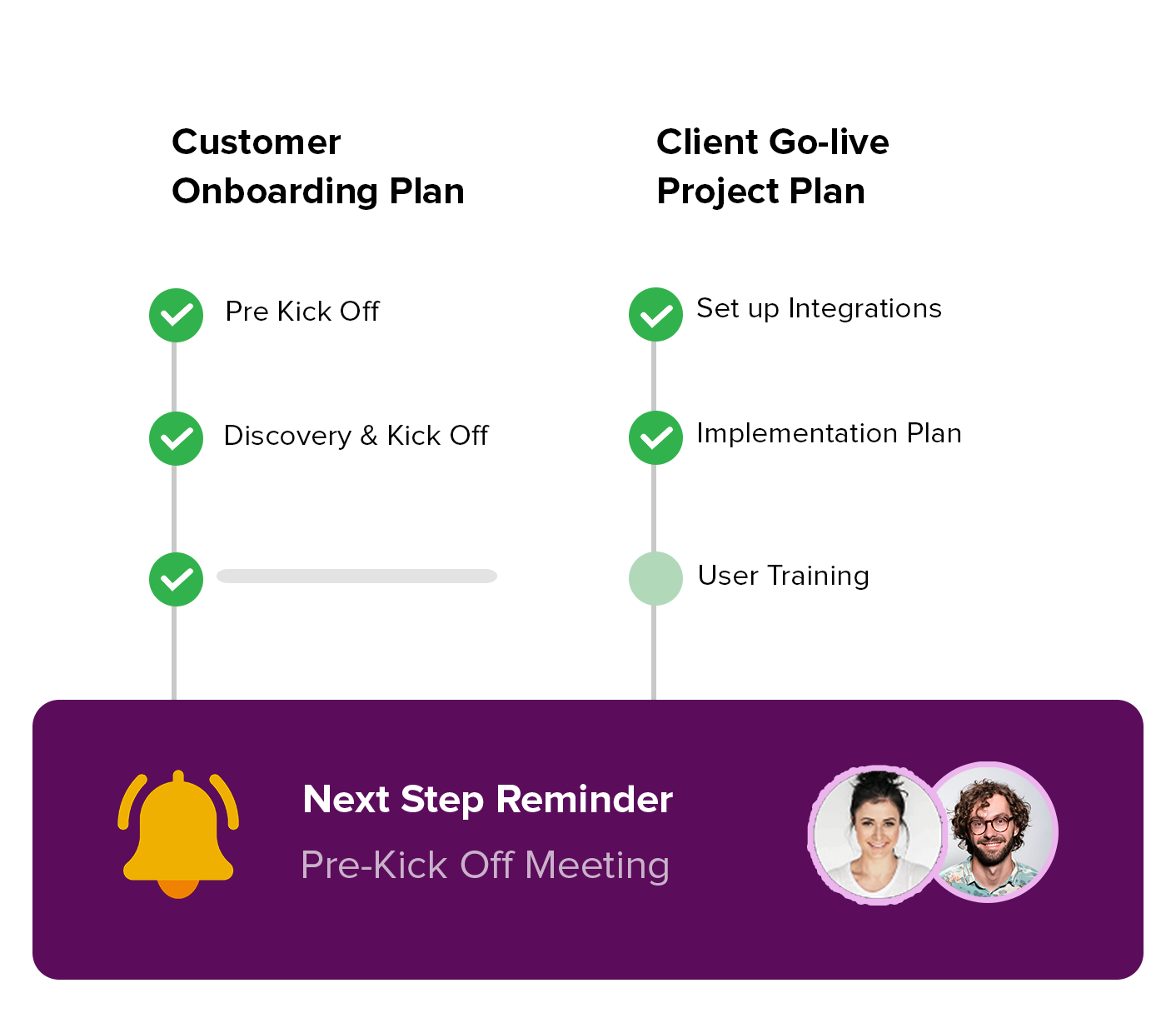Limited-Time Special Offer: Get Exclusive Lifetime Deal Now!
Mutual Action Plan Template
Mutual Action Plan (MAP) is a roadmap that helps both the seller and buyer work together to successfully close a deal.
Get Started
Every sales professional knows the frustration of a deal that seemed closed, but unexpectedly, the client starts to miss his tasks and disengages from the dialogue, resulting in the loss of the deal.
Mutual Action Plan template offers a deal-closing map that the buyer and seller follow together, with the goal of closing the deal successfully. It includes important steps, deadlines, and responsibilities for each phase of the project.
In simple terms, it is a to-do list that can be shared both internally and externally. Additionally, a shared space can include resources and documents related to the project.
One of the goals of using MAP is to help sales professionals to engage clients early in the process and increase the chance of closing the deal.
About This Template:
After assisting companies in successfully creating and adapting Mutual Action Plans (MAPs) in their day-to-day operations, we decided to compiled this guide and template.
The goal is to help sales and revenue teams start using MAP quickly and successfully. In this article, you will find important information about MAP strategies, including when and how to use them.
What is a Mutual Action Plan?
A Mutual Action Plan (MAP) is a collaborative map designed to align the goals and actions of both a seller and a buyer towards the successful closure of a deal.
Challange: In today's B2B product purchases, there are typically 11 stakeholders involved in the decision-making process.
This number is anticipated to rise in the upcoming years, indicating a trend towards more complex purchasing decisions with more people involved.
With a strategic approach to addressing customer needs and removing obstacles to purchase, MAPs can significantly increase win rates for sales and revenue teams.
Benefits of using MAP:
- Building repeatable and predictable sales process
- Faster time-to-value
- Shorter sales cycle
- Improved win rate
- Better retention
- Increase customer retention
Grounded in the latest data and research, MAPs are increasingly recognized as an important part of effective sales strategies in 2024.
Buying decisions are often made internally and the sales team cannot control or address objectives at the right time.
TIP: Sellers cannot control decisions that are made internally but MAPs can help sellers to empower champions with centralized places where all questions are strategically addressed.
Research indicates that MAPs significantly enhance the likelihood of deal completion by keeping both sides engaged from the early stage of the deal.
MAPs can eliminate ambiguity and address buyers' questions upfront, which builds trust and a sense of professionalism.
They are particularly vital in complex B2B sales cycles, where multiple stakeholders and decision-makers are involved, helping to navigate through complexities and align everyone's expectations.
Read in more details: What is a Mutual Action Plan
MAP Template
Boost deal conversion rates
- Share Mutual Action Plan
- Set Reminders
- Always Know The Next Step

What is the Goal of This Mutual Action Plan Template?
The goal of this MAP template is to create a structured, transparent pathway towards achieving a successful sale or partnership.
MAP serves several key purposes:
- Building repeatable sales process
- Predictable sales funnel
- Faster time-to-value
- Shorter sales cycle
- Improved buying experience
- Stronger relationships
- Increase customer retention
Outlining each step of the sales or implementation process helps companies avoid unnecessary delays, making the journey from initial contact to deal closure or project completion more direct and timely.
Mutual Action Plan Template
This template can be tailored to represent your brand in the best possible way. Each phase is fully customizable with a drag-and-drop builder. You can use pre-built components or create your own set of materials and tasks.
Key elements of MAP:
- Introduction
- Stakeholder Identification
- Goals and Objectives
- Key Milestones and Deadlines
- Task List
- Resources and Document
Introduction
In this phase, both parties come together, setting the stage for what they plan to achieve together.
What is included in template:
- Welcome letter
- Overview presentation
- Company and product details
TIP: Keep it concise and focused on how the partnership can achieve mutual success.
Stakeholder Identification
List all stakeholders involved from both the buying and selling organizations to make planning and closing deals easier.
What is included in template:
- Stakeholder list
- Roles and responsibilities chart
Goals and Objectives
In this step, you decide on the finish line—what you're all working towards. It's like choosing the destination before you start a road trip, so everyone's heading in the same direction.
Define specific, measurable goals that both parties aim to achieve.
What is included in template:
- SMART goals worksheet
- Objective-setting guide
Example: Increase the monthly website traffic by 30% within the next four months through targeted social media campaigns and SEO optimization, measuring progress weekly.
TIP: Use SMART criteria to make objectives clear and attainable. Read more about this approach.
Key Milestones and Deadlines
This part is about marking the big checkpoints along the way and when you aim to reach them.
Outline major milestones and their expected completion dates. Set realistic deadlines and consider potential obstacles in your timeline planning.
What is included in template:
- Project timeline template
- Milestone tracker spreadsheet
Example: A major milestone might be the completion of the initial training sessions for the client's staff by the end of the second month.
Task List
Break down everything that needs to be done into smaller steps.
Create a detailed list of tasks required to reach each milestone, assigned to specific individuals. Break down tasks into manageable actions to prevent overwhelm and ensure progress.
This ensures that nothing gets forgotten and everyone knows what they need to do and when.
What is included in template:
- Detailed task checklist
- Next step alerts
Example: Tasks could include configuring the software settings to match the client’s pricing structure and importing their current inventory details.
Create Tasks, Always Know What is The Next Step
Establish a collective action plan with your buyers to navigate the process to its final stages faster.

Resources and Documents
Think of this as gathering all the tools and materials you need before starting a project. It's about making sure you have everything on hand, so you're prepared to tackle the tasks ahead.
Essential documents might include a user manual for the software and access to a series of tutorial videos on inventory management.
What is included in template:
- Training manuals
- Product tour
- Legal and compliance documents
How to Use MAP Template Successfully: Step-by-Step Guide
Where to Start
A great starting point for implementing MAP is to review past deals and successful onboarding experiences.
This retrospective analysis allows you to identify the key elements that contributed to past successes and areas where improvements can be made.
Understanding these critical components from real-world examples provides a solid foundation on which to build effective and tailored MAPs.
Key advised:
- Review Past Deals: Analyze successful and unsuccessful deals to identify what worked and what didn't.
- Break the Sales Process Down into Clear Steps: Outline each phase of your sales process from initial contact to closing the deal.
- Identify Key Elements: Pinpoint essential milestones, tasks, and responsibilities critical to the sales process.
- Avoid Over-Complicating: Keep it straightforward to ensure ease of use and understanding for all parties involved.
- Start Small: Implement the MAP with a few deals first, collect feedback, and make necessary adjustments.
Using MAPs Into Your Day to Day Work
Incorporating MAPs into your daily operations is a strategic move that requires planning.
To ensure a high adoption rate among your team and clients, it's crucial to approach MAP integration thoughtfully. This means providing training, demonstrating the direct benefits of using MAPs.
- Step 1: Explain to the team benefits and how it will streamline the sales process.
- Step 2: Address concerns from Account Executives (AEs) and ensure they understand the MAP's value.
- Step 3: Getting prospects involved
Break down everything that needs to be done into smaller steps.
How Success Looks Like with MAPs
Using MAPs effectively transforms your sales process, aligning your team's efforts with customer expectations and leading to more successful outcomes.
- Sales cycles become shorter due to clearer expectations and streamlined processes.
- There's an increase in deal closure rates as both parties are aligned and committed.
- Customer satisfaction improves because they are engaged and understand the value from the outset.
- The sales team can manage more deals efficiently as each step is predefined and structured.
- Continuous feedback leads to refined sales strategies, making each MAP more effective than the last.
The Challenges With MAPs
Overcoming challenges with adoption is crucial in the successful implementation of Mutual Action Plans.
Challenges often arise from skepticism or unfamiliarity with the process or technology among Account Executives (AEs) and prospects. Addressing these challenges head-on through education, demonstrating the benefits, and sharing success stories.
An important part of achieving a high adoption rate is ensuring that MAPs are user-friendly and evolve based on feedback.
Common Challenges: AEs might not adopt MAPs, action plans might remain unchanged from day 1 to go-live.
Solution: Offer training, showcase success stories, and ensure the MAP evolves with feedback and as the deal progresses.
Mutual Action Plan Use Case Examples
MAP Example for SaaS Customer Onboarding
Onboarding new clients into a SaaS platform requires a structured approach to ensure smooth adoption. A MAP for SaaS Customer Onboarding outlines each critical step in familiarizing customers with the service.
Process Example:
- Phase 1: Overview
- Introduction to the platform's capabilities and defining success metrics.
- Phase 2: Setup & Onboarding
- Customizing the user interface and functionality to meet the client's needs.
- Phase 3: Data Migration
- Securely transferring client data into the new system.
- Phase 4: QA
- Testing the setup to ensure everything works as intended.
- Phase 5: Go-Live Plan
- Finalizing the launch strategy and preparing for official use.
MAP Example For Professional Services
Professional services, such as consulting or marketing agencies, benefit from MAPs by delineating the path from contract signing to project completion.
Process Example:
- Phase 1: Initial Assessment
- Understanding the client's current situation and objectives.
- Phase 2: Strategy Development
- Creating a detailed plan of action tailored to the client's goals.
- Phase 3: Implementation
- Executing the agreed-upon strategies and actions.
- Phase 4: Review & Adjust
- Evaluating progress and making necessary adjustments.
- Phase 5: Project Wrap-Up
- Finalizing the project and measuring success against initial goals.
Read more about the customer onboarding process for marketing agencies.
MAP Example for B2B Enterprise-Level Sales (Complex Deals)
Enterprise-level sales often involve complex solutions and longer sales cycles, making the inclusion of a proof of concept phase essential.
Process Example:
- Phase 1: Needs Analysis
- A deep dive into the enterprise's requirements and challenges.
- Phase 2: Solution Customization
- Tailoring the product or service to meet specific enterprise needs.
- Phase 3: Proof of Concept
- Demonstrating the solution's effectiveness in a controlled environment.
- Phase 4: Implementation Planning
- Preparing for deployment across the enterprise.
- Phase 5: Deployment & Evaluation
- Rolling out the solution and assessing its impact.
Read more about the customer onboarding in the B2B sales process
Benefits of using a Mutual Action Plan template
- Repeatable and predictable sales process
- No more email ping pong
- Easy hand-offs between sales and AE’s
- Increase in conversion rates
- Stand-out buying experience
Simplified Top-funnel Interactions
At the top of the sales funnel, where prospects are just beginning to engage with your brand, MAPs play a crucial role in organizing and guiding these initial interactions.
TIP: Incorporate interactive elements like self-serve demo, product tour or quizzes in your MAP at this stage to engage prospects actively and personalize their journey based on their responses.
Middle Funnel Control and Increased Engagement
In the middle of the funnel, prospects are considering their options and evaluating your solution more closely.
Here, MAPs offer a framework for managing these considerations, helping to maintain momentum and steer the prospect towards a decision.
Example: Develop a MAP segment that includes detailed product comparisons, case studies, and tailored demonstrations to address specific concerns or questions that arise at this stage.
TIP: Regular check-ins and updates included in the MAP can help keep the prospect engaged and provide opportunities to address any emerging obstacles or questions.
Seamless Bottom Funnel Collaboration
As prospects move to the bottom of the funnel, close collaboration becomes key to finalizing the sale. MAPs are most valuable at the bottom funnel stage.
Example: In a bottom funnel MAP, you might include detailed onboarding schedules, specific legal and compliance requirements, personalized training plans for the customer's team, and a checklist for the initial setup of services or products.
This ensures that every party knows exactly what needs to be done, by whom, and when, making the final push towards closing a deal as smooth and efficient as possible.
Key Takeaways
When to use a Mutual Action Plan Template?
Mutual Action Plan templates are especially beneficial in scenarios, such as for larger opportunities where the Annual Contract Value exceeds $10,000
MAP can help in complex deals that involve 5+ stakeholders (which usually means a longer sales cycle), or for complicated onboarding processes, whether for a Proof of Concept (POC) or post-sale.
Who is Using MAPs
Regardless of the industry, companies are finding MAPs invaluable for their ability to clarify, and align the journey towards mutual goals.
Roles in the Company
- Sales Teams: Sales representatives and account executives use MAPs to align with prospects and customers on the steps required to close deals successfully.
- Customer Success Managers: These professionals rely on MAPs to guide new customers through the onboarding process, ensuring they understand and utilize the product or service fully.
- Project Managers: In the context of delivering services or complex products, project managers utilize MAPs to coordinate tasks, timelines, and responsibilities across teams.
- Marketing Teams: While not always directly involved in creating MAPs, marketing professionals benefit from the alignment and understanding of customer journeys that MAPs facilitate.
Set up your Mutual Action Plan in just a few minutes!
Boost your sales with our easy-to-use portal software. Bring your team and clients together on one platform where everything they need is just a click away.

Portal Builder
Custom Forms
Tasks & Boards

